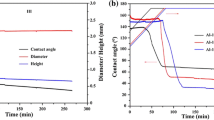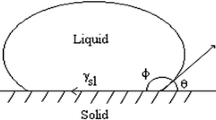Abstract
Wetting of α–Al2O3 single crystals with different crystallographic orientations, R(011¯2), A(112¯0), and C(0001), by molten Cu at 1423–1673 K was studied using an improved sessile drop method mainly in a reducing Ar–3%H2 atmosphere to determine the effect of the alumina surface orientation on the wettability and adhesion in this system. The contact angles were generally in the range of 110–117°, and the work of adhesion was between 0.7 and 0.8 J m−2, without a significant dependence on the alumina surface orientation. This result was explained by the possibly close bond strengths of Cu–O at the oxygen-terminated Cu/[R(011¯2)] and Cu/[A(112¯0)] α-alumina interfaces and Cu–Al at the Al-terminated (or Al-rich) Cu/[C(0001)] α-alumina interface under high-temperature and low oxygen partial pressure conditions. Additionally, the effects of alumina surface dissolution in the region around the triple junction and H2 in the atmosphere were examined. Some reasons for the controversy on the bonding nature at the Cu/α–Al2O3 interfaces, i.e., Cu–O or Cu–Al on earth, present in the literature were also addressed.
Similar content being viewed by others
References
B. Schwartz: Microelectronics packaging II. Am. Ceram. Soc. Bull. 63, 577 (1984).
M.C. Wu and D.W. Goodman: Particulate Cu on ordered Al2O3: Reactions with nitric oxide and carbon monoxide. J. Phys. Chem. 98, 9874 (1994).
D.W. Goodman: Model studies in catalysis using surface science probes. Chem. Rev. 95, 523 (1995).
B.C. Allen and W.D. Kingery: Surface tension and contact angles in some liquid metal-solid ceramic systems at elevated temperatures. Trans. Metall. Soc. AIME 215, 30 (1959).
A.C.D. Chaklader, A.M. Armstrong, and S.K. Misra: Interface reactions between metals and ceramics: IV. Wetting of sapphire by liquid copper-oxygen alloys. J. Am. Ceram. Soc. 51, 630 (1968).
T.E. O’Brien and A.C.D. Chaklader: Effect of oxygen on the reaction between copper and sapphire. J. Am. Ceram. Soc. 57, 329 (1974).
S.P. Mehrotra and A.C.D. Chaklader: Interfacial phenomena between molten metals and sapphire substrate. Metall. Trans. B 16B, 567 (1985).
P.D. Ownby and J. Liu: Surface energy of liquid copper and single-crystal sapphire and the wetting behavior of copper on sapphire. J. Adhes. Sci. Technol. 2, 255 (1988).
K. Nogi, K. Oishi, and K. Ogino: Wettability of solid oxides by liquid pure metals. Mater. Trans. JIM 30, 137 (1989).
H. Matsumoto, M.R. Locatelli, K. Nakashima, A.M. Glaeser, and K. Mori: Wettability of Al2O3 by liquid Cu as influenced by additives and partial transient liquid-phase bonding of Al2O3. Mater. Trans. JIM 36, 555 (1995).
A. Meier, M.D. Baldwin, P.R. Chidambaram, and G.R. Edwards: The effect of large oxygen additions on the wettability and adhesion of copper-oxygen alloys on polycrystalline alumina. Mater. Sci. Eng. A 196, 111 (1995).
P.D. Chidambaram, A. Meier, and G.R. Edwards: The nature of interfacial phenomena at copper-titanium/alumina and copperoxygen/alumina interfaces. Mater. Sci. Eng. A 206, 249 (1996).
V. Ghetta, J. Fouletier, and D. Chatain: Oxygen adsorption isotherms at the surfaces of liquid Cu and Au-Cu alloys and their interfaces with Al2O3 detected by wetting experiments. Acta Mater. 44, 1927 (1996).
D. Chatain, V. Ghetta, and J. Fouletier: Metal/oxide interfaces: Chemistry, wetting, adhesion, and oxygen activity, in Proceedings of Ceramic Microstructures’ 96: Control at the Atomic Level, edited by A.P. Tomsia and A.M. Glaeser (Plenum, New York, 1998), p. 349.
E. Saiz, A.P. Tomsia, and R.M. Cannon: Wetting and work of adhesion in metal/oxide system, in Proceedings of Ceramic Microstructures’ 96: Control at the Atomic Level, edited by A.P. Tomsia and A.M. Glaeser (Plenum, New York, 1998), p. 65.
E. Saiz, A.P. Tomsia, and R.M. Cannon: Ridging effects on wetting and spreading of liquids on solids. Acta Mater. 46, 2349 (1998).
M. Diemer, A. Neubrand, K.P. Trumble, and J. Rödel: Influence of oxygen partial pressure and oxygen content on the wettability in the copper-oxygen-alumina system. J. Am. Ceram. Soc. 82, 2825 (1999).
P. Vikner: DEA report, LTPCM, INP Grenoble, France, 1993. Reported in N. Eustathopoulos, M.G. Nicholas and B. Drevet, Wettability at High Temperatures (Elsevier Science, Oxford, U.K., 1999), pp. 205–207.
U. Alber, H. Müllejans, and M. Rühle: Wetting of copper on α–Al2O3 surfaces depending on the orientation and oxygen partial pressure. Micron. 30, 101 (1999).
P. Shen, H. Fujii, T. Matsumoto, and K. Nogi: The influence of surface structure on wetting of α–Al2O3 by Al in a reduced atmosphere. Acta Mater. 51, 4897 (2003).
P. Shen, H. Fujii, T. Matsumoto, and K. Nogi: Surface orientation and wetting phenomena in Si/α-alumina system at 1723 K. J. Am. Ceram. Soc. (in press).
H. Fujii, H. Nakae, and K. Okada: Interfacial reaction wetting in the boron nitride/molten aluminum system. Acta Metall. Mater. 41, 2963 (1993).
P. Shen, H. Fujii, T. Matsumoto, and K. Nogi: Critical factors affecting the wettability of α–Al2O3 by molten aluminum. J. Am. Ceram. Soc. 87(11), 2151 (2004).
B. Gallois and C.H.P. Lupis: Effect of oxygen on the surface tension of liquid copper. Metall. Trans. B. 12B, 549 (1981).
Z. Morita and A. Kasama: Surface tension of liquid copper in dilute oxygen concentrations. J. Jpn. Inst. Met. 40, 787 (1976).
A. Kasama, T. Iida, and Z. Morita: Temperature dependence of surface tension of liquid pure metals. J. Jpn. Inst. Met. 40, 1030 (1976).
A. Portevin and P. Bastien: C. R. Acad. Sci. 202, 1072 (1937).
P.P. Budnikov and F. Xaritonov: Izv. Akad. Nauk SSSR, Neorg. Mat. 3(3), 496 (1967). Reported in S.H. Overbury, P.A. Bertrand, and G.A. Somorjai: The surface composition of binary systems: Prediction of surface phase diagrams of solid solutions. Chem. Rev. 75(5), 547 (1975).
W.D. Kingery: Metal-ceramic interactions: IV. Absolute measurement of metal-ceramic interfacial energy and the interfacial adsorption of silicon from iron-silicon alloys. J. Am. Ceram. Soc. 37(2), 42 (1954).
S.K. Rhee: Critical surface energies of Al2O3 and graphite. J. Am. Ceram. Soc. 55(6), 300 (1972).
P. Nikolopoulos: Surface, grain-boundary and interfacial energies in Al2O3 and Al2O3–Sn, Al2O3–Co systems. J. Mater. Sci. 20, 3993 (1985).
G. Levi and W.D. Kaplan: Aluminum-alumina interface morphology and thermodynamic from dewetting experiments. Acta Mater. 51, 2793 (2003).
J-H. Choi, D-Y. Kim, B.J. Hockey, S.M. Wiederhorn, C.A. Handwerker, J.E. Blendell, W.C. Carter, and A.R. Roosen: Equilibrium shape of internal cavities in sapphire. J. Am. Ceram. Soc. 80(1), 62 (1997).
M. Kitayama and A.M. Glaeser: The Wulff shape of alumina: III. Undoped alumina. J. Am. Ceram. Soc. 85(3), 611 (2002).
P.W. Tasker: Surface of magnesia and alumina, in Advance in Ceramics: Structure and Properties of MgO and Al2O3Ceramics, edited by W.D. Kingery (The American Ceramic Society, Columbus, OH, 1984), p. 176.
W.C. Mackrodt, R.J. Davey, and S.N. Black: The morphology of α–Al2O3 and α–Fe2O3: The importance of surface relaxation. J. Cryst. Growth 80, 441 (1987).
S. Blonski and S.H. Garofalini: Molecular dynamics simulations of α-alumina and γ-alumina surfaces. Surf. Sci. 295, 263 (1993).
I. Manassidis and M.J. Gillan: Structure and energetics of alumina surfaces calculated from first principles. J. Am. Ceram. Soc. 77, 335 (1994).
D.H. Gay and A.L. Rohl: Marvin: A new computer code for studying surfaces and interfaces and its application to calculating the crystal morphologies of corundum and zircon. J. Chem. Soc., Faraday Trans. 1 91, 925 (1995).
H. Suzuki, H. Matsubara, J. Kishino, and T. Kondoh: Simulation of surface and grain boundary properties of alumina by molecular dynamics method. J. Ceram. Soc. Jpn. 106, 1215 (1998).
N.H. de Leeuw and S.C. Parker: Effect of chemisorption and physisorption of water on the surface structure and stability of α- alumina. J. Am. Ceram. Soc. 82, 3209 (1999).
A. Marmier and S.C. Parker: Ab initio morphology and surface thermodynamics of α–Al2O3. Phys. Rev. 69, 115409 (2004).
C. Scheu, G. Dehm, M. Rühle, and R. Brydson: Electron-energyloss spectroscopy studies of Cu–α–Al2O3 interfaces grown by molecular beam epitaxy. Philos. Mag. A 78, 439 (1998).
C. Scheu, W. Stein, and M. Rühle: Electron energy-loss near-edge structure studies of a Cu/(112¯0) α–Al2O3 interface. Phys. Status Solidi B 222, 199 (2000).
T. Sasaki, K. Matsunaga, H. Ohta, H. Hosono, T. Yamamoto, and Y. Ikuhara: Atomic and electronic structure of Cu/α–Al2O3 interfaces by pulsed laser deposition. Sci. Technol. Adv. Mater. 4, 575 (2003).
C. Scheu: Manipulating bonding at a Cu/(0001)Al2O3 interface by different substrate cleaning processes. Interface Sci. 12, 127 (2004).
M. Gao, C. Scheu, T. Wagner, W. Kurtz, and M. Rühle: Bonding between Cu and α–Al2O3. Z. Metallkd. 93, 438 (2002).
R. Di Felice and J.E. Northrup: Theory of the clean and hydrogenated Al2O3 (0001)-(1 × 1) surfaces. Phys. Rev. B 60, 16287 (1999).
X.G. Wang, A. Chaka, and M. Scheffler: Effect of the environment on α–Al2O3 (0001) surface structures. Phys. Rev. Lett. 84, 3650 (2000).
J. Ahn and J.W. Rabalais: Composition and structure of the Al2O3 (0001)-(1×1) surface. Surf. Sci. 388, 121 (1997).
M. Backhaus-Ricoult: Gibbs adsorption at β alumina-copper interfaces. J. Eur. Ceram. Soc. 23, 2747 (2003).
M. Backhaus-Ricoult and M.F. Trichet: Comparison of interfacial chemistry at Cu/α-alumina and Cu/γ-alumina interfaces. Z. Metallkd. 94, 250 (2003).
W. Zhang, J.R. Smith, and A.G. Evans: The connection between ab initio calculations and interface adhesion measurements on metal/oxide systems: Ni/Al2O3 and Cu/Al2O3. Acta Mater. 50, 3803 (2002).
G.L. Zhao, J.R. Smith, J. Raynolds, and D.J. Srolovitz: Firstprinciples study of the α–Al2O3(0001)/Cu(111) interface. Interface Sci. 3, 289 (1996).
I.G. Batyrev and L. Kleinman: In-plane relaxation of Cu(111) and Al(111)/_–Al2O3(0001) interfaces. Phys. Rev. B. 64, 033410 (2001).
X.G. Wang, J.R. Smith, and M. Scheffler: Adhesion of copper and alumina from first principles. J. Am. Ceram. Soc. 86, 696 (2003).
N.C. Hernández and J.F. Sanz: First principles study of Cu atoms deposited on the α–Al2O3 surface. J. Phys. Chem. B 106, 11495 (2002).
Z. Lodziana and J.K. Norskov: Adsorption of Cu and Pd on α–Al2O3(0001) surfacees with different stoichiometries. J. Chem. Phys. 115, 11261 (2001).
T.M. French and G.A. Somorjai: Composition and surface structure of the (0001) face of α–Al2O3 by low-energy electron diffraction. J. Phys. Chem. 74, 2489 (1970).
M. Gautier, G. Renaud, L.P. Van, B. Villette, M. Pollak, N. Thromat, F. Jollet, and J-P. Duraud: _–Al2O3 (0001) surfaces: Atomic and electronic structure. J. Am. Ceram. Soc. 77, 323 (1994).
G. Renaud, B. Villette, I. Vilfan, and A. Bourret: Atomic structure of the α–Al2O3 (0001) (311/2 × 311/2)R ± 9° reconstruction. Phys. Rev. Lett. 73, 1825 (1994).
J.A. Kerr: Strengths of chemical bonds, in CRC Handbook of Chemistry and Physics, edited by D.R. Lide and H.P.R. Frederikse (76th edition, CRC Press, Inc., Boca Raton, FL, 1995–1996), pp. 9–51.
B. Ealet and E. Gillet: Metal-alumina interface: Influence of the metal electronegativity and of the substrates stoichiometry. Surf. Sci. 367, 221 (1996).
P. Alemany, R.S. Boorse, J.M. Burlitch, and R. Hoffmann: Metalceramic adhesion: Quantum mechanical modeling of transition metal–Al2O3 interfaces. J. Phys. Chem. 97, 8464 (1993).
K. Nath and A.B. Anderson: Oxidative bonding of (0001)_–Al2O3 to close-packed surfaces of the first transition-metal series, Sc through Cu. Phys. Rev. B 39, 1013 (1989).
P.D. TePsesch and A.A. Quong: First-principles calculation of α-alumina (0001) surfaces energies with and without hydrogen. Phys. Status Solidi 217, 377 (2000).
J.A. Kelber, C. Niu, K. Shepherd, D.R. Jennison, and A. Bogicevic: Copper wetting of α–Al2O3(0001): Theory and experiment. Surf. Sci. 446, 76 (2000).
X.G. Wang, J.R. Smith, and M. Scheffler: Effect of hydrogen on Al2O3/Cu interfacial structure and adhesion. Phys. Rev. B 66, 073411 (2002).
Z. Lodziana, J.K. Norskov, and P. Stoltze: The stability of the hydroxylated (0001) surface of α–Al2O3. J. Chem. Phys. 118, 11179 (2003).
R. Schmid: A thermodynamic analysis of the Cu–O system with an associated solution model. Metall. Trans. B 14B, 473 (1983).
Author information
Authors and Affiliations
Corresponding author
Rights and permissions
About this article
Cite this article
Shen, P., Fujii, H. & Nogi, K. Effect of substrate surface orientation on the wettability and adhesion of α–Al2O3 single crystals by molten Cu. Journal of Materials Research 20, 940–951 (2005). https://doi.org/10.1557/JMR.2005.0127
Received:
Accepted:
Published:
Issue Date:
DOI: https://doi.org/10.1557/JMR.2005.0127




